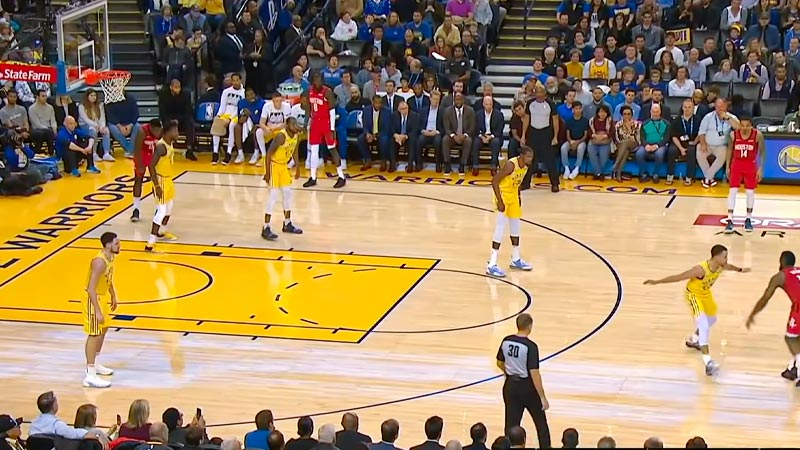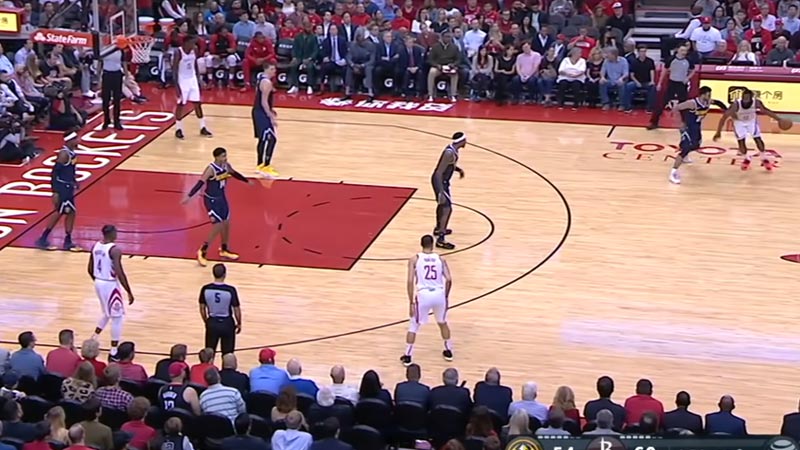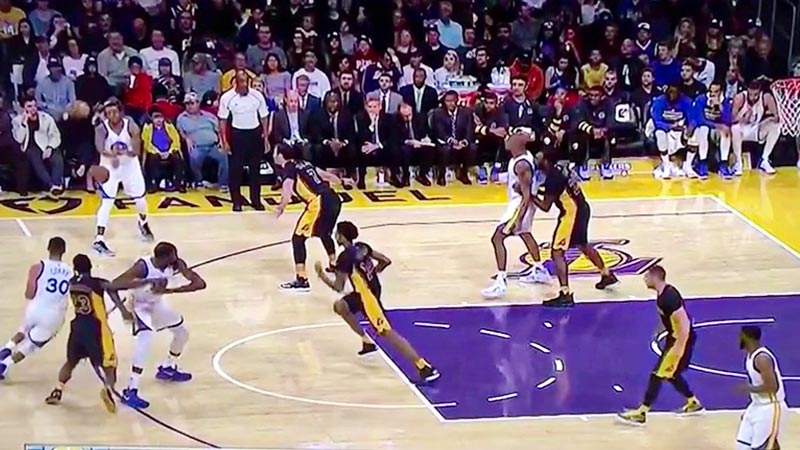Pass and Screen Away is a fundamental offensive strategy in basketball that involves a player passing the ball to a teammate and immediately setting a screen to create scoring opportunities.
This powerful tactic relies on effective communication, precise execution, and coordinated movement.
In this comprehensive blog post, we will explore the intricacies of Pass and Screen Away, including its execution, types of passes, and screen cuts involved.
Also, we will check out variations and options, as well as the numerous benefits it brings to a team’s offensive arsenal. Stay focused.
What Is Pass and Screen Away in Basketball?
Pass and Screen Away is a strategic offensive play in basketball that involves precise coordination and movement among players.
It begins with a player passing the ball to a teammate and immediately initiating a quick movement to set a screen away from the ball. The purpose of this screen is to create separation between the teammate who received the pass and their defender.
By doing so, it allows the receiver to have more space and options to create scoring opportunities or make plays for themselves or their teammates.
When executing Pass and Screen Away, the passer must deliver an accurate and well-timed pass to their teammate. The pass should be crisp and on target, allowing the receiver to catch the ball in a favorable position.
As soon as the pass is released, the passer quickly moves away from the ball and positions themselves to set a screen.
The screen is a pivotal aspect of Pass and Screen Away. The player setting the screen aims to block the path of the defePostnder guarding the receiver, creating a temporary obstacle and buying precious time for the receiver to operate.
How to Execute Pass and Screen Away in Basketball?

To execute Pass and Screen Away successfully in basketball, effective communication, and timing are essential.
The players involved must be in sync and have a clear understanding of their roles and responsibilities within the play.
Here’s a breakdown of the key elements involved in executing Pass and Screen Away:
Crisp and Accurate Pass
The passer plays a critical role in the execution of Pass and Screen Away. They should deliver a crisp and accurate pass to their teammate, taking into account the distance, defense, and positioning of the receiver.
The pass should be timed well to ensure the recipient has the best opportunity to catch the ball in a scoring position.
Proper Positioning and Solid Screen
The screener is responsible for establishing proper positioning to set an effective screen. This involves positioning themselves between the defender and the teammate receiving the pass, creating an obstacle for the defender to navigate.
The screener must also set a solid screen by making contact with the defender and holding their position to create separation for the receiver.
Reading the Defense
The player receiving the pass in Pass and Screen Away must be adept at reading the defense. They need to assess the movements and positioning of defenders to determine the best course of action.
This includes recognizing if the defender goes under or over the screen if help defense is coming, or if there are opportunities to attack the basket or pass to an open teammate.
Utilizing Cuts
The receiver should utilize various cuts to create separation from their defender. Different types of cuts, such as V-cuts, L-cuts, backdoor cuts, or curl cuts, can be employed to exploit the movement created by the screen.
By using these cuts effectively, the receiver can create scoring opportunities for themselves or draw defensive attention, opening up passing lanes for their teammates.
Making the Best Decision
Upon receiving the pass and evaluating the defense, the player must make the best decision based on the situation. They can choose to shoot, drive to the basket, or pass to an open teammate.
This decision-making process requires good court awareness, basketball IQ, and the ability to adapt to changing circumstances in real time.
Executing Pass and Screen Away successfully relies on the coordination and understanding of all players involved.
Clear communication, timing, and precise execution of passes, screens, and cuts are paramount to create scoring opportunities and exploit defensive weaknesses.
Types of passes used in Pass and Screen Away

In the Pass and Screen Away offense, there are various types of passes that can be utilized based on the specific situation on the court.
Each type of pass serves a purpose and can be chosen strategically to maximize the effectiveness of the play.
The most common types of passes used in Pass and Screen Away include chest passes, bounce passes, and overhead passes.
Chest Passes
A chest pass is one of the most fundamental and commonly used passes in basketball. It involves throwing the ball directly from the chest area with both hands, using a quick and powerful motion.
Chest passes are typically used when the distance between the passer and the receiver is relatively short and there are no defenders in the passing lane.
They provide a quick and accurate way to move the ball to a teammate and maintain good ball control.
Bounce Passes
Bounce passes are executed by bouncing the ball off the floor toward the intended recipient. This type of pass is effective when there are defenders in the passing lane or when the receiving player is not in a position to catch a chest pass.
Bounce passes are lower and harder to intercept, making them useful for passing through traffic or when the passing angle is obstructed.
They are especially effective when passing to a teammate cutting toward the basket or in a pick-and-roll situation.
Overhead Passes
Overhead passes, also known as lob passes or baseball passes, involve throwing the ball from an overhead position with both hands.
These passes are generally used when the distance between the passer and the receiver is greater or when the passing lane is obstructed by defenders.
Overhead passes provide an arc to clear the defense and can be effective in hitting a teammate on a fast break or when making long-distance cross-court passes.
The choice of pass type in Pass and Screen Away depends on several factors, including the distance between the players, the defensive pressure, and the positioning of the receiver.
Types of screens in Pass and Screen Away
Types of screens play a crucial role in Pass and Screen Away, a common offensive strategy in basketball.
By understanding and utilizing different screen types effectively, teams can create scoring opportunities for their teammates and disrupt the defense.
Let’s take a closer look at some of the key screen types used in Pass and Screen Away:
Down Screen
The down screen is executed when an offensive player sets a screen on a teammate’s defender who is moving toward the baseline or down the court.
This screen is commonly used to free up a shooter or a cutter by creating separation from their defender. The objective is to allow the player coming off the screen to receive a pass or create a scoring opportunity.
Flare Screen
A flare screen involves an offensive player setting a screen for a teammate near the perimeter, away from the ball. The screener’s goal is to create space for the teammate to receive a pass on the wing or in the corner.
The teammate coming off the flare screen can either shoot from the outside or drive to the basket, depending on the defensive reaction.
Back Screen
In a back screen, an offensive player sets a screen on a teammate’s defender from behind.
The purpose of this screen is to create a mismatch or confusion in the defense by allowing the screened player to cut toward the basket. This screen is often used to generate alley-oop opportunities or easy layups for the cutting player.
Pick-and-Pop Screen
The pick-and-pop screen involves a player setting a screen for a teammate who has the ball, typically near the perimeter.
Instead of rolling towards the basket like in a traditional pick-and-roll, the screener “pops” out to an open area, usually beyond the three-point line.
This creates space for the ball handler to drive or pass to the popping player for an open jump shot.
Each screen type has specific objectives and can create different scoring opportunities for the teammate receiving the pass.
Coaches and players must understand the strengths and weaknesses of their personnel and utilize the appropriate screen type based on the situation.
Types of cuts used in Pass and Screen Away
Cuts play a crucial role in the execution of the Pass and Screen Away play in basketball.
These cuts allow players to create separation from defenders and position themselves for optimal scoring opportunities.
Let’s explore some of the common types of cuts utilized in Pass and Screen Away:
V-cut
The V-cut is a fundamental cut used to create space between the offensive player and their defender.
In this cut, the offensive player starts by moving toward the defender as if they are going to receive a pass. They then quickly change direction, making a sharp cut away from the defender in the shape of a “V.”
This sudden change of direction helps the offensive player gain an advantage and receive the pass in an open position.
L-cut
The L-cut is another effective cut used in Pass and Screen Away. This cut involves the offensive player initially moving toward the defender and then making a sharp 90-degree turn, creating an L-shape with their movement.
The L-cut allows the offensive player to quickly change direction and get open for a potential pass.
Backdoor cut
The backdoor cut is a deceptive cut that involves the offensive player faking a cut toward the ball before quickly changing direction and cutting toward the basket behind their defender.
This cut is particularly effective when the defender overplays the passing lane, allowing the offensive player to create separation and receive a lob pass or score an easy basket.
Curl cut
The curl cut is commonly used when the offensive player is coming off a screen.
In this cut, the offensive player moves towards the screener and then curls around them, using their body as a shield to prevent the defender from recovering.
The curl cut allows the offensive player to catch the ball in a scoring position or continue their drive toward the basket.
Executing these cuts effectively, players in the Pass and Screen Away play can create openings for themselves and their teammates, leading to increased scoring opportunities.
These cuts require precise timing, communication, and awareness of the defensive positioning to maximize their effectiveness.
Variations and Options in Pass and Screen Away
Pass and screen away is a basketball offensive play that involves a player passing the ball to a teammate and then immediately setting a screen for another teammate away from the ball. This play creates opportunities for scoring or ball movement. Here are some variations and options in pass and screen away:
Basic Pass and Screen Away
The simplest variation involves the ball handler passing to a teammate on the wing or in the corner, and then cutting away to set a screen for another teammate. The screener can choose to roll to the basket or pop out for a shot, depending on the defensive coverage.
Double Screen
In this variation, two players simultaneously set screens for the player without the ball. This creates confusion for the defense and allows the screener to have multiple options for a shot or drive to the basket.
Flare Screen
Instead of setting a traditional screen, the player without the ball uses a flare screen to move to an open spot on the perimeter. This is particularly effective for shooters who can catch and shoot quickly after coming off the screen.
Backdoor Cut
After setting the screen away from the ball, the screener can quickly cut toward the basket, looking for a lob pass or a bounce pass for an easy layup. This option exploits the defensive focus on the player coming off the screen.
Read and React
Instead of having predetermined actions, players involved in the pass and screen-away play can read the defense and make decisions based on what they see. This allows for improvisation and capitalizing on defensive weaknesses.
Dribble Handoff
Instead of passing the ball, the ball handler can execute a dribble handoff to the teammate without the ball. This allows for a quick exchange of positions and can create driving lanes or open shooting opportunities.
Second Screen
After the initial screen away, the player who received the pass can immediately give the ball back to the original ball handler, who uses a second screen from the initial screener. This option keeps the defense off balance and opens up various scoring opportunities.
Pick and Pop
Instead of rolling to the basket after setting the screen, the screener “pops” out to the perimeter for a jump shot. This variation is effective when the screener is a capable shooter and draws the defender away from the paint.
These are just a few examples of the variations and options in pass and screen-away plays. Coaches and players can adapt and modify these plays to suit their team’s strengths and exploit the weaknesses of the defense they are facing.
Benefits of Pass and Screen Away in Basketball
Pass and Screen Away is an effective offensive strategy in basketball that provides numerous benefits to the team executing it. Let’s delve deeper into the advantages of this play:
Movement and Defensive Rotations
When a player receives a pass and immediately sets a screen away from the ball, it creates movement on the court. This movement forces the defense to adjust and rotate to cover the offensive players involved in the play.
As a result, passing and screening away puts pressure on the defense and opens up scoring opportunities. It can lead to confusion, and defensive breakdowns, and create mismatches that the offense can exploit.
Increased Scoring Opportunities
Pass and Screen Away play allows for multiple scoring options. The player receiving the pass can use the screen to create separation from their defender, providing an opportunity for an open shot or a drive to the basket.
Additionally, as the defense rotates to cover the screened player, it often leaves other offensive players open. This creates passing lanes and scoring chances for teammates who can receive the ball in advantageous positions.
Improved Spacing
Spacing is a crucial element in basketball. Pass and Screen Away helps create better spacing on the court, as it encourages players to move away from the ball. By moving away from the ball and setting screens, offensive players create distance between themselves and their defenders.
This opens up the court, making it more difficult for defenders to provide help defense or double-team. Improved spacing allows for better offensive flow, increased driving lanes, and better opportunities for shooters.
Enhances Ball Movement
Pass and Screen Away emphasizes ball movement and player involvement. It encourages players to pass the ball quickly and make quick decisions based on the movement of their teammates.
By incorporating this play, teams can foster a more unselfish and team-oriented style of play, leading to better ball movement, improved decision-making, and increased opportunities for assisted baskets.
Exploiting Mismatches and Defensive Breakdowns
Pass and Screen Away can exploit mismatches and defensive breakdowns caused by the defensive rotations. As the offense moves the ball and screens away, the defense may make mistakes in communication, positioning, or switching.
These mistakes can lead to advantageous matchups for the offense, such as a smaller guard guarding a taller player in the post.
By recognizing and capitalizing on these opportunities, the offense can exploit the defensive weaknesses and create high-percentage scoring chances.
The Pass and Screen Away play offers numerous benefits to the offense. It creates movement, forces defensive rotations, enhances spacing, promotes ball movement, and allows players to exploit mismatches and defensive breakdowns.
FAQs
Is Pass and Screen Away effective against zone defenses?
Yes, Pass and Screen Away can be effective against zone defenses as it helps create movement and force defenders to make decisions.
The screens and cuts can create openings in the defense and lead to scoring opportunities.
Can Pass and Screen Away be used with players of all positions?
Absolutely. Pass and Screen Away can involve players of any position on the court.
It can be particularly effective when executed with players who possess good passing skills, shooting ability, and understanding of the play.
How important is communication in executing Pass and Screen Away?
Communication is vital in executing Pass and Screen Away. Players need to communicate their intentions, timing, and the type of screen to be set.
Clear communication helps ensure that players are on the same page and execute the play smoothly.
Can Pass and Screen Away be used in fast-break situations?
Yes, Pass and Screen Away can be adapted for fast-break situations. It allows for quick ball movement, cuts, and screens, enabling players to create scoring opportunities before the defense has a chance to set up.
What is the role of the player receiving the pass in Pass and Screen Away?
The player receiving the pass in Pass and Screen Away must read the defense, utilize cuts to create separation and make the best decision based on the situation. They can shoot, drive to the basket, or pass to an open teammate.
Bottom Line
Pass and Screen Away is a versatile offensive strategy that can greatly enhance a team’s scoring opportunities.
By executing precise passes, setting effective screens, and utilizing various cuts, players can create movement, disrupt defenses, and open up scoring chances for themselves and their teammates.
Incorporating Pass and Screen Away into a team’s offensive arsenal requires practice, communication, and understanding of the play’s principles.
Mastering this fundamental tactic can elevate a team’s offensive efficiency and create a dynamic and unpredictable attack on the basketball court. Thank you for your support.







